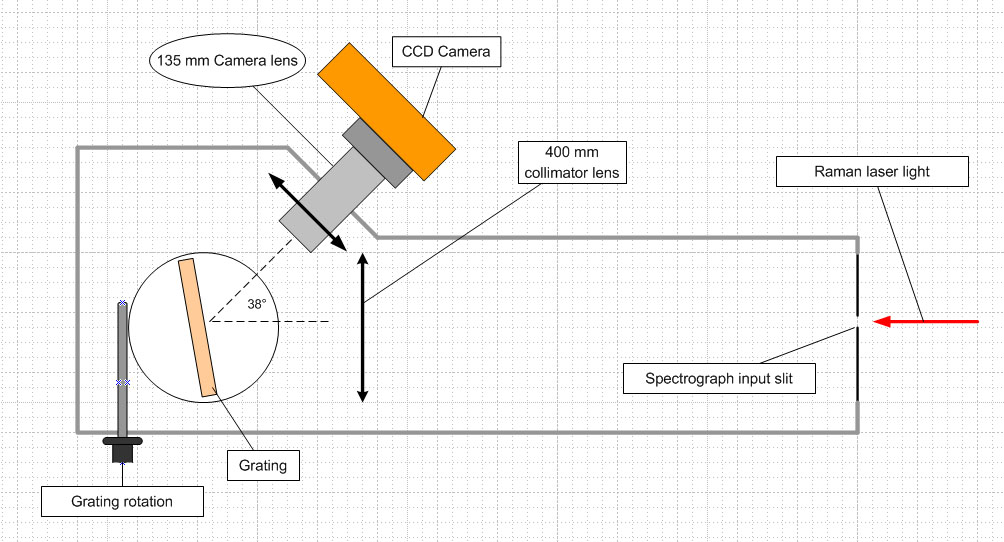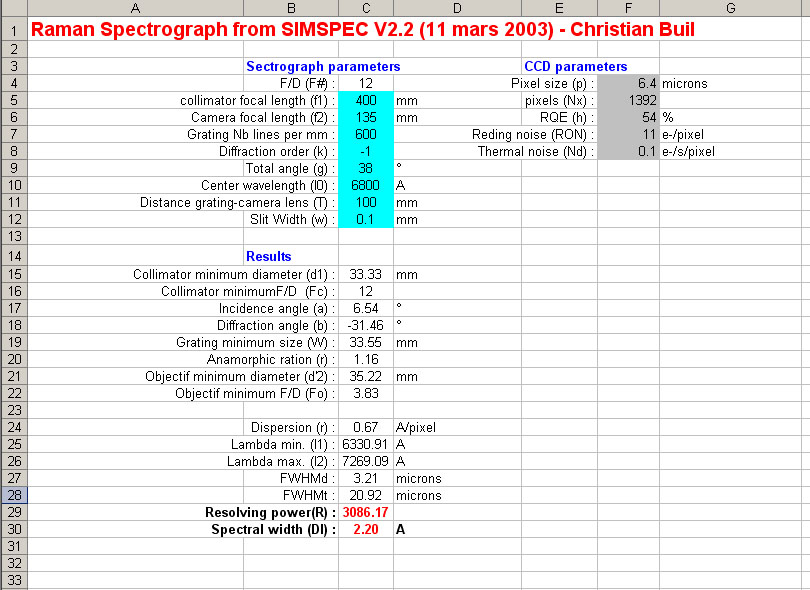Raman spectrograph version 2: design.
|
As explained in a previous page of this description of the Raman microscope, the use of the Jobin Yvon H20 spectrograph was not an ideal solution because of the field curvature aberration and vignetting which prevent a wide spectral range to be recorded at a time. To completely demonstrate that a Raman microscope could be completely home made with commonly available mechanical and optical parts, I decided to rebuild the spectrograph to improve the performances of the instrument. The cost of the spectrograph described below is approximately one half of a new H20 monochromator with better results. I decided finally to build the so called classical spectrograph with a reflection grating as described in the literature for amateur astronomical spectroscopy (see reference page). This spectrograph as described in the drawing below uses two lenses and a plane grating as optical elements. The advantage of lenses is the cost and the ease of use but the main drawback is of course the presence of achromatic aberration even if achromatic lenses were used. This aberration has a minimal effect in Raman spectroscopy for minerals as the wavelength range is usually limited close to the laser emission line. The laser beam coming from the microscope enter the spectrograph through the inlet slit. The slit is situated at the focal point of the collimator lens so that a parallel beam of light is diffracted from the grating. The camera lens forms an image of the spectrum onto the CCD detector. The f/value of the exit beam from the microscope has been measured approximately at f/13 so the spectrograph optics has been calculated with a f/value of f/12 (see sheet below). The collimator has a focal length of 400 mm for a diameter of 50 mm. The grating size is 50X50 mm. It means that the opening of the input optics of this spectrograph is much larger than required ( f/value = f/8). This facilitates the adjustment of the whole optic system and prevents vignetting. The angle between the collimator axis and the camera optic axis has been chosen at about 38° which is a common value found in the published literature. The grating is a ruled grating with 600 grooves per millimeter blazed at 750 nm giving high intensity for a red laser. The grating position can be adjusted with a screw to allow the user to examine different spectral regions. In practice with the helium-neon laser, the grating is used at two different positions: low range from 100 to 2000 cm-1 (~ 630 - 730 nm) and CH , OH band range from 2500 to 4000 cm-1 (~ 750 - 850 nm). The focal length of the camera lens is lower than the one of the collimator to concentrate the light for a better signal and to adjust the wavelength range on the camera sensor to a suitable value (100 to 2000 cm-1) for Raman spectroscopy. This focal length is a compromise between the availability of the lens, f/value ,the cost of the lens, the intensity of spectra and the spectral window. Finally, I have chosen a photographic lens to improve the quality of the spectrum image. The first version of this spectrograph was working with a 100 mm achromatic NIR lens from Thorlabs but the quality of images on the CCD was rather poor so the photographic lens seems to be preferable as imaging element for this kind of spectrograph design. On the other hand, for the collimator, the 400 mm achromatic lens is suitable because this lens is only imaging a small object (the entrance slit) located on its focal point so aberrations are minimized. The calculation of the parameters of the complete spectrograph is based on the excellent article and spreadsheet of Christian Buil about astronomical spectroscopy. The results are reproduced below.
|
|
Simplified drawing of the spectrograph.
|
|
Parameters for the design of the spectrograph. A complete working spreadsheet for the calculation of spectrographs can be found on the web page of Christian Buil (see references).
|
| The calculation results for a f/12 spectrograph with parameters of optical elements described above and the CCD characteristics reported in the right column suggests a grating size and collimator diameter of 33 mm (50 mm installed exceeds the minimum value). The f/value of the camera lens is more challenging as the program calculates a value of f/3.8. The Olympus 135mm objective lens used here has an opening of f/3.5 which is just a little better than the required value. The spectral window from 633 to 726 nm is enough for practical purposes as mentioned in the tests pages.
|

